During those rangefinder days of '50 and early days of Nikon F of '60, use of flash bulb was still very popular. Flash bulbs were originally designed to supersedes old-fashioned way of using pile of flash powder where photographer held aloft and burned it to make a bright light for artificial illumination. In the same manner, electronic flash units introduced later also slowly but surely replaced the flash bulbs.
 |
Some of the early bulb flash such as the solidedly built bracket handle flash BC-B and compact units BC-3 and BC-5 were companion flash for the rangefinder models. When the F was introduced, it had a provision to accept those flash bulb units which were originally designed for Nikon rangefinder cameras. |
 |
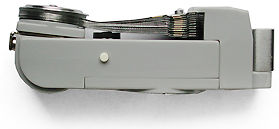 |
|
Front view
of a Nikon BC-5 |
Side view of a Nikon BC-7 |
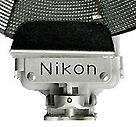 |
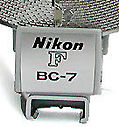 |
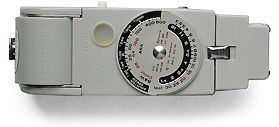 |
|
The flash foot of the BC-5 is fittingly designed for Nikon rangefinder. |
The flash foot can be mounted directly onto Nikon F/F2 camera. |
The calculator dial of the BC-7 has been simplified as compared with earlier BC-5. |
Note: During its era, when the Nikkormat models were marketed -Nikon midrange SLR models were not using the special accessory shoe the Nikon F and F2 have, it has a standard ISO-type accessory shoe. To use BC-7 onto any Nikon camera with conventional ISO-type accessory shoe, there is an accessory adapter called "Nikkormat Accessory Shoe". Further, there is also a special cord that permit off camera flash operation with the BC-7 Fan-folded flash.
The BC-7, a revised and improved bulb flash from earlier similar flash type such as BC-3 and BC-5 which came with a dedicated Nikon F/F2 type accessory shoe, uses similar glass flash bulbs and require the respective cameras such as Nikon F and Nikkormat to set to bulb setting on the camera section to operate and timed it correctly. Although it sounded primitive, but all these oldies were the pioneered model with many modern days flash features such as tilting flash head etc. and you can even adjust their angle of illuminance. But strangely, many of these useful and considerate features have been left out in many of the electronic portable flash units Nikon designed over the next 10 years.
Our friend, Michael Liu has some detailed operation sequences to explain:
"...BC-7 Bulb
Flash... On the front of the flash, you can see the reflector, the three-way
bulb socket in its center, and the F/F2-type foot. When the reflector is folded,
you can see the test button. The left side has the two-socket (non-PC) sync connector,
while the right side has a small white charge tester button. The silver button on
top of the unit is the bulb ejector. On the back, from top to bottom, are the test
lamp, exposure calculator-disc, and the rear-cover clip. The reflector may be rotated
through an angle of 135 degrees, from directly pointed at the soon-to-be-blinded
subject to nearly facing the wall behind you.
The first step should
be to insert the battery, which is a 15V dry cell, Mallory 504 or equivalent (Duracell
504, Radio Shack Unlimited #RSU10048510, or Varta V74PX, which is alkaline and not
recommended). Slide the rear-cover clip down and remove the cover (which holds the
exposure-disc); the positive terminal should be aligned towards the top of the unit.
Then mount the unit on the camera. Before
loading any film, wind the advance lever and hold in the (front-mounted) test button
for a few seconds. When you release the shutter, the test lamp should light up to
indicate that everything is working properly.
Now you can deploy
the reflector by hooking it into one of the two slots. The "nearer" slot
(shallow bowl) illuminates approximately a 35mm lens's field-of-view, while the "farther"
slot (deeper bowl) illuminates about a 45mm lens's FOV. Of course, you can leave
the reflector furled and use bare-bulb flash at a fraction of the cost of a new Sunpak
120J (on the other hand, the Sunpak offers 3 auto-apertures, manual power attenuation,
and on one model, TTL flash control).
The three-way bulb
socket will accept bulbs of the S.C. bayonet-base, minature base (M2, M3, etc.),
and all-glass (AG-1) types. When you insert a bulb, the BC-7 begins to charge its
capacitor; full charge is reached when the test lamp glows after pressing the white
charge test button. Note that bulbs are either clear or blue-coated: clear bulbs
are suitable for black and white film, because their light output is very warm, while
blue-coated bulbs approximate the sun's light output temperature (appox. 5880K).
Blue-coated bulbs are designated by a "B" at the end of their name. The
flashbulbs recommended by J.D. Cooper in his Nikon-Nikkormat Handbook are
the FP 6, FP 26, M3, and AG-1 (preferred in that order, because of their sync speeds).
Basically, appropriate
sync speeds are determined by the type of bulb in use (different types have differing
flash duration); in general, type FP bulbs should sync at all shutter speeds. Determining
exposure is relatively simple. You line up the shutter speed in use with the ASA
film speed in use (use the black scale for black-and-white film with clear bulbs,
or the red scale with blue-coated bulbs) and determine your aperture based on the
shooting distance. For shutter speeds slower than 1/30, you can use the guide-number
to determine exposure....". -
Michael Liu -
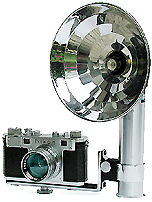 |
But bulb flash does has their limitations and setback for a good around flash solution such as time delay during operation, inconsistent output and cumbersome to carry around etc. Those days, it was not too uncommon to see busy photographers had actually waist belt full of flash bulbs to go for an important photographic assignment ! Anyway, when the SLR Nikon F was introduced, the company also inherited the flash bulb unit originally designed for Nikon rangefinder cameras. The BC-7 was almost a replica of the early BC-3 and BC-5. |
Towards second half of the sixties, many had already realized the potential of electronic flash and manufacturers were quick to react. Nikon introduced their first electronic flash in 1969 with a handle mount flash SB-1 - except it was entirely control by manual output with reduced power output (Full or 1/4 power) to monitor its intensity. Frankly, I would rather believe the Medical Nikkor 200mm f/5.6 Auto introduced back in 1962 with a built-in flash as the first Nikon electronic flash where the built-in flash actually provides auto-exposure.
| Previous | NEXT | 2/6 Nikon Original Speedlights
Nikon Flash Units: BC-Series| Original Nikon Speedlight
SB-2
| SB-3 | SB-4
| SB-5
| SB-6 | SB-7E
| SB-8E
| SB-9 | SB-E
| SB-10
SB-11
| SB-12 | SB-14 | SB-140 UV-IR| SB-15 | SB16A | SB-17 |
SB-18, SB-19 | SR2/SM-2 Ringlights | SB-21A (SB-29) Macro flash |
Flash Accesories | SF-1
Pilot Lamp
Nikon AF-TTL Speedlights
| SB-20 | SB-22 | SB-23 | SB-24 | SB-25 | SB-26 | SB-27 | SB-28 | Nikon SB-29(s) | Nikon
SB-30
| Nikon
SB-600
| Nikon
SB-880
(updated)
Nikon AF-TTL Speedlight DX-Series: Nikon SB-28DX | SB-50DX | SB-80DX (updated)
Various
Options in Power
Sources,
Flash
Accessories
and more info on 200mm
Medical Nikkor lens
with a built-in flash.
System
Accessories:
Motor
Drives
/ Prisms / Screens / Macro / Film
Backs
/ Flash
Other Accessories:
DS-1 / DS-2
/ DS-12 / eyepiece
/ DH-1 / cases
/ Cable
releases / Miscellaneous
| Message Board | for
your favourite Nikon
F2 Series SLR model(s)
| Message Board | for your Nikon Optics in a shared environment
| Message Board | Specifically for Dispose or Looking for Nikon/Nikkor Photographic
Equipment
| Back |
to Main
Index Page of Nikon
F2 Series SLR models
| Back | Main Index Page of
Pictorial History of Nikon SLRs
 |
The Eyes of Nikon:- |
Fisheye-Nikkor Lenses - Circular | Full Frame | Ultrawides Lenses - 13mm15mm18mm20mm | Wideangle Lenses - 24mm28mm35mm |
Standard Lenses - 45mm 50mm 58mm | Telephoto Lenses - 85mm105mm135mm180mm & 200mm |
Super-Telephoto Lenses - 300mm 400mm 500mm 600mm 800mm 1200mm |
Special Application lenses:
Micro-Nikkor Lenses - 50mm~55mm -60mm 85mm -105mm 200mm Micro-Zoom 70-180mm
Perspective Control (PC) - 28mm 35mm PC-Micro 85mm
Dedicated Lenses for Nikon F3AF: AF 80mm f/2.8 | AF 200mm f/3.5 EDIF
Depth of Field Control (DC): 105mm 135mm
Medical Nikkor: 120mm 200mm
Reflex-Nikkor Lenses - 500mm 1000mm 2000mm
Others: Noct Nikkor | OP-Nikkor | UV Nikkor 55mm 105mm | Focusing Units | Bellows-Nikkor 105mm 135mm
Nikon Series E Lenses: 28mm35mm50mm100mm135mm | E-Series Zoom lenses: 36~72mm75~150mm70~210mm
MF Zoom-Nikkor Lenses: 25~50mm | 28~45mm | 28~50mm | 28~85mm | 35~70mm | 36~72mm E | 35~85mm | 35~105mm | 35~135mm |
35~200mm | 43~86mm | 50~135mm | 50~300mm | 70~210mm E | 75~150mm E | 80~200mm | 85~250mm |
100~300mm | 180~600mm | 200~400mm | 200~600mm | 360~1200mm | 1200~1700mm
Tele-Converters: TC-1 | TC-2 | TC-200 | TC-201 | TC-300 | TC-301 | TC-14 | TC-14A | TC-14B | TC-14C | TC-14E | TC-16 | TC-16A | TC-20E
![]()
Nikon F
| Nikon F2 |
Nikon
F3
| Nikon F4 |
Nikon
F5
| Nikon F6 |
Nikkormat / Nikomat |
Nikon FM
| Nikon FE/ FA | Nikon EM/FG/FG20 | Nikon Digital SLRs | Nikon - Other models
MIR Supports for Photographic Community: Various Message Boards/Community
Forums
Nikon
F-series|
Nikon
F2-series|
Nikon
F3-series|
Nikon F4-series| Nikon
F5-series|Nikkormat/Nikomat-series
Nikon FM-series|Nikon
FE-series|Nikon
FA|Nikon
Digital
SLR
series|Various
Nikon
Models|Nikkor
Optic
-shared
Others:- Free Trade Zone - Photography| Free Trade Zone - Business Community |Free To Zouk - Photographic Community
Apple's Mac Public Community Message Board | Windows based PC &
Apple/Mac
Public Community Trade Exchange Centre
Recommended links to understand
more technical details related to the Nikkor F-mount and production Serial Number:
http://rick_oleson.tripod.com/index-153.html by: my friend, Rick Oleson
http://www.zi.ku.dk/personal/lhhansen/photo/fmount.htm by: Hansen, Lars Holst
http://www.mir.com.my/rb/photography/hardwares/nikonfmount/lens2.htm
http://www.photosynthesis.co.nz/nikon/serialno.html
About this photographic site.
HOME - Photography in Malaysia |
Copyright © 2000. leofoo ®. MIR Web Development Team.
In
memory of my friend Com.
Augusto Staut,
Brazil, 1971-2000.
Credit: Chuck Hester, US for his patience, encouragement
and help to setup the various content in this site; Robert Johnson for some of his original
images on the F2H-MD appeared in this site; my ex-staff, KiaSu for his superb
3-D logo appeared in this Nikon F2 site; Marc Vorgers from Holland who
generously provide me with some of his images of F2AS; MCLau®, who has so much time with me to
re-edit the content in this site and not to mention buying a Nikon Coolpix 990 just
for this site. Keat Photo,
Kuala Lumpur for providing
their Nikon F2A to take some images for this site; again, Mr Edward Ngoh the
great camera collector who provides us his collection of F2AS with MD-2; hawkeye.photographic.com
for their images on the Speed Magny film backs; Sean Cranor for his image
on Nikon F2 25th Anniversary Model; Ted Wengelaar®, Holland for his continuous
flow of input on some of the early Nikon bodies; CYLeow ® , photo editor of the Star
newspaper, Malaysia for some of his images used in this site. Ms Rissa Chan, Sales manager from
Shriro Malaysia who has helped to provide some of the very useful input. HiuraShinsaku®,
Nikomat ML, Japan for some of his images on various F2 models; my staff, Wati, Maisa, Mai and my nephew, EEWyn®, who volunteered and helping me
did so many of the film scanning works. Contributing photographers or resellers:
Jen Siow, Foo KokKin, Arthur Teng, Mark Fallander, John
Ishii, Ed Hassel, YoonKi Kim, Jean-Louis, M.Dugentas (Dell Corner.com.), Mr "Arsenall" and a few images mailed
in from surfers with no appropriate reference to their origin. Dedicated to KU Yeo, just to express our mutual regrets over the outcome of
a recent corporate event. Made with a PowerMac, broadcast with a Redhat Linux powered server.
![]()
![]()